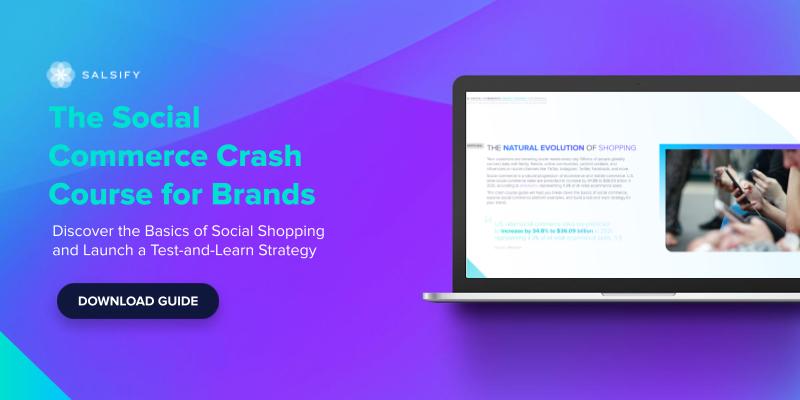

Become a Social Commerce Leader
Download our guide for quick tips for building your brand's effective social commerce strategy.
DOWNLOAD GUIDEPIM
Manage all product content in one central system of record.
Syndication
Easily syndicate product content to every consumer touch point.
Enhanced Content
Enrich product pages with below-the-fold content and rich media.
Intelligence Suite
Bring AI-powered capabilities directly into your Salsify workflows.
Grocery Accelerator
Leverage the first-ever category-wide PXM accelerator in the grocery industry.
GDSN Data Pool
Synchronize standard supply chain, marketing, and ecommerce attributes globally.
Digital Shelf Analytics
Continuously optimize your organization’s product content syndication.
Catalog Sites
Share secure, on-brand, and always up-to-date digital product catalogs.
Automation and AI
Automate business processes and enhance Salsify workflows with AI.
PXM Platform, Integrations, and APIs
Integrate the PXM platform with the rest of your enterprise systems architecture.
Supplier Onboarding
Accelerate supplier onboarding while ensuring your schema requirements are met.
Product Listing
Sell products faster with Product Listing.
Content Enrichment
Increase online conversions with Content Enrichment.
Automation
Save time and increase operational efficiency with retail automation.
SXM Platform, Integrations, and APIs
Integrate the SXM platform with the rest of your enterprise systems architecture.
Syndication Network
Automate how you exchange product content data to the digital shelf.
Enhanced Content Network
Turn product pages into product experiences with Enhanced Content.
Commerce Platform Integrations
Create winning product experiences everywhere shoppers are, including on owned sites.
GDSN Data Pool
Synchronize standard supply chain, marketing, and ecommerce attributes globally.
Open Catalog
Connect to the digital shelf faster with an open, standardized, and free product catalog.
Resources
Resource Library
Explore our ecommerce resources to get everything you need to win on the digital shelf.
Blog
Read our blog to get actionable insights for navigating changing markets and industry demands.
Webinars
Watch our on-demand ecommerce webinars to gain expert advice and tips from our community of industry leaders.
Customer Blog
Gain the latest tips, industry trends, and actionable ecommerce insights.
Knowledge Base
Investigate our knowledge base to build your Salsify skills and understanding.
API
Examine our comprehensive API and webhook guides to start working with Salsify quickly.

Download the report to get expert insights, consumer research, and top industry trends.

The future of ecommerce is here, and much of it’s happening on social media.
Social media platforms are home to a growing share of ecommerce sales. Social commerce, also known as social shopping, is expected to grow steadily in almost all markets.
The power of social commerce is already being realized for global brands. For example, social shopping is so widespread among Asian consumers that, according to Statista, it will be worth $1.298 billion in 2023 and climb to $3 trillion by 2026. Insider Intelligence expects it to be worth $107.17 billion in the U.S. by 2025, and Statista predicts that global social ecommerce sales will reach $2.9 trillion by 2026.
This growth illustrates the potential that investing in social commerce can unlock. But to succeed in social commerce, brands first need to create great shoppable content to share on their social profiles.
Here’s an in-depth look at what this type of content is and how you can use it to drive social conversion.
Shoppable content is content that contains purchase links. Some forms of this content are relatively new, while others have been around for years. For example, an advertisement with a “buy now” link under an image is technically a basic form of this content. So is a blog article with links to product pages embedded in it.
However, the content that's shoppable with the greatest potential is often social content that directly encourages sales. Examples of content that's shoppable could include videos with purchase links in the caption, or they could be Instagram, Facebook, or even TikTok posts with links that take users right to a product page.
Here are three common examples of this kind of content.
Instagram is an excellent platform for content that's shoppable. With the Instagram Shopping feature, brands can post beautiful product images, like this one from West Elm below, and tag the products available for sale. Users can then click on those tags to make their purchase.
Source: West Elm Instagram
Instagram is also an excellent platform for making user-generated content (UGC) shoppable. In the example below, beauty brand Glossier shared an image posted by an influencer. This lets the brand leverage content from an external source that’s more likely to produce high consumer engagement.
Source: Glossier Instagram
Pinterest may not be a social media juggernaut like Instagram, but it still has plenty of users. And according to Pinterest’s research, those users spend double the amount that non-users spend on online purchases.
Good content that's shoppable on Pinterest shows products staged in eye-catching, inspirational settings and tagged with purchase links.
Amid the virality of social posts, there’s still a place for text-based content. Department store Marks & Spencer produces blogs relevant to seasonal trends. Links to products are embedded in those blogs, resulting in content that helps shoppers find exactly what they’re looking for.
Source: Marks & Spencer
Here are four of the top benefits of using this kind of content.
This type of content takes much of the friction out of ecommerce, letting shoppers move from initial interest to a closed sale in minutes. This can increase conversions and reduce the rate of cart abandonment.
A simple, frictionless buying experience is just as good for shoppers as it is for your conversion rates. It means there’s no frustration or confusion during the buying process. The result is greater enthusiasm about your brand and an increased likelihood of brand loyalty.
Twenty-eight percent of shoppers browse social media to get inspiration for things to do or buy, and over 26% said they look for specific products, according to Influencer Marketing Hub. That means this type of content catches consumers when they’re most open to being persuaded into making a purchase.
Social proof that suggests to other consumers that your brand is likable and worth buying from. A great example of this is when your audience is engaged with your content, and they leave likes or comments on your posts.
Content that's shoppable works best for brands with products that lend themselves to attractive, inspirational images — think fashion or home décor.
It also performs better with some demographics than others. For example, younger consumers are much more likely to make purchases on social platforms. Tech company Duel found that 75% of millennials and 64% of Generation Z have made purchases from social media in the past, but only 35% of boomers have made purchases, and 40% would never consider it.
Strategic use of the right type of content that's shoppable on the right platforms can be beneficial to almost any brand. It’s just a matter of knowing how to do it successfully.
So, how do you create great content that's shoppable? Here are five principles to follow.
Your images should stop shoppers in their scrolling tracks. Use imagery that’s attractive, displays your products in use, and communicates your brand’s identity.
Viewers want to see your products in action. Beyond that, the same general principles as imagery apply: Make sure it’s attractive, entertaining, and aligned with your brand.
User-generated content (UGC) will always be more trustworthy to the average consumer than content produced by your brand. Reshare posts from satisfied consumers to prove the attractiveness of your product.
Even in visual-first mediums, good copy can be a deciding factor for conversions. Be sure to include captions that list all essential details about a product. The copy shouldn’t draw attention to itself, but it still needs to be thorough and clear.
Nearly 40% of social shoppers are primarily motivated by deals and discounts, according to Influencer Marketing Hub. Promote sales and offer exclusive deals to take advantage of shoppable content’s shortened funnel.
Content that's shoppable creates unique opportunities for driving quick conversions and keeping consumers engaged. Not only that, but it helps you become one of the innovative brands taking full advantage of the approaching shift toward social commerce.

Download our guide for quick tips for building your brand's effective social commerce strategy.
DOWNLOAD GUIDENicole D’Angelo (she/her) is a freelance writer, editor, and content marketer with over eight years of experience creating content for various industries. Previously, she managed content production for business-to-business (B2B) and business-to-consumer (B2C) brands, including Fortune 500 companies.
Standing out on the digital shelf starts with access to the latest industry content. Subscribe to Below the Fold, our monthly content newsletter, and join other commerce leaders.